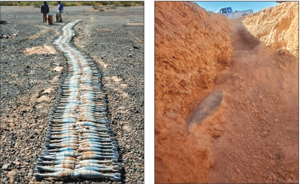
31 Mar Ammunition Recovery section employs experts in the explosives field
YUMA — Imagine, the scene in a movie where a bomb is about to explode when an Explosive Ordnance Disposal (EOD) trained expert shows up to safely defuse it.
The TRAX Ammunition Recovery Section better known as “Demo,” performs similar work and more to support the Yuma Test Center (YTC) mission at Yuma Proving Ground.
The Demo team is made up of nearly two-dozen veterans who attended the Naval School of Explosive Ordnance Disposal, at Eglin Airforce base — a joint service school.
“All of our team served in the military as EOD techs, that’s the minimum requirement. Some were in four years while others served much longer, retiring from the military before coming to YPG.”
As a part of the larger Armaments and Ammunition Division, this section of specially trained veterans from all branches of service provide support in the safe testing of ammunition.
“A large part of what we do is safety, we help setup target impacts by escorting the different test support organizations,” explains, Ben Wallace, Ammunition Recovery supervisor. Safety protocols require a safety escort on impact areas, meaning where explosives have landed.
“Before we escort them out there, we clear the area to make sure there’s no unexploded ordnance (UXO) on the ground or any other hazards that might be dangerous for them.”
While YTC meticulously maps impact areas and safety fans, YTC first started as the Desert Training Center under Maj. Gen. George Patton and UXO is believed to still be littered throughout the area.
In addition to clearing an area and escorting teams, Demo recovers ordnance. A lot of ordnance, Demo has safely recovered nearly 19,000 items in the last decade.
“Generally, if there is a dud on a Lot Acceptance Test, they want us to dig it up. So, we will find where it impacted, we will use a backhoe to dig it out of the ground, then we will bring it back and cut it open.”
This allows the customers to examine why the projectile failed to detonate.
Recovery has many forms explains Wallace. “We look at how it’s designed and determine how we can we safely recover the test item. Occasionally it is a matter of waiting a certain amount of time for all the electronics to die. Other times it is something that is always going to be hazardous, and we must do it remotely. We prefer the munitions that we can pick up and carry away because they failsafe.”
When recovering remotely, the team has a handful of robots to help them out. The robots have names like, Wolverine, Brutus, Mini and The Wizard, and are used depending on the situation.
The last step of the process is demilitarizing or demiling what’s not longer needed.
“One of the facilities we operate is the Open Burn, Open Detonation site that is a munitions treatment facility permitted through the Arizona Department of environmental quality.”
Another unique find at Demo is the library of ordnance. The room is filled with inert ammunition, associated parts, and training aids.
“All this ordnance represents items that have been fired and recovered here,” states Wallace.
This in house stockpile aids Demo in training their team.
“It is good to go over the fuzing with our team. We have some cut aways to help visualize how they work mechanically. Some of our training aids are designed so that we can take them apart. This allows us to practice with an inert version before we perform a disassembly operation or failure analysis on a live one.”
